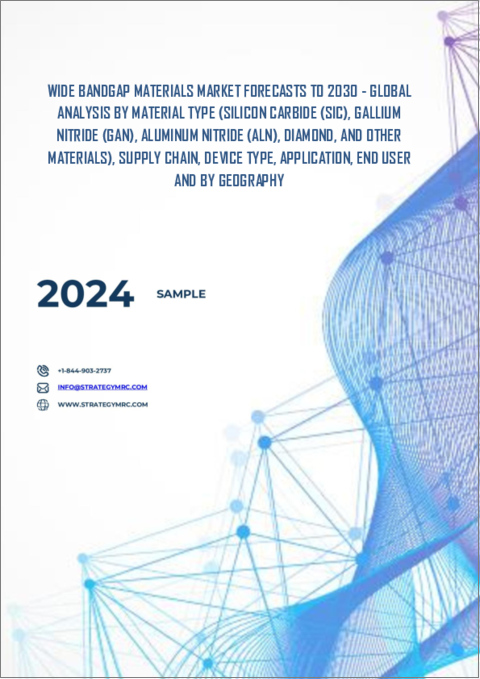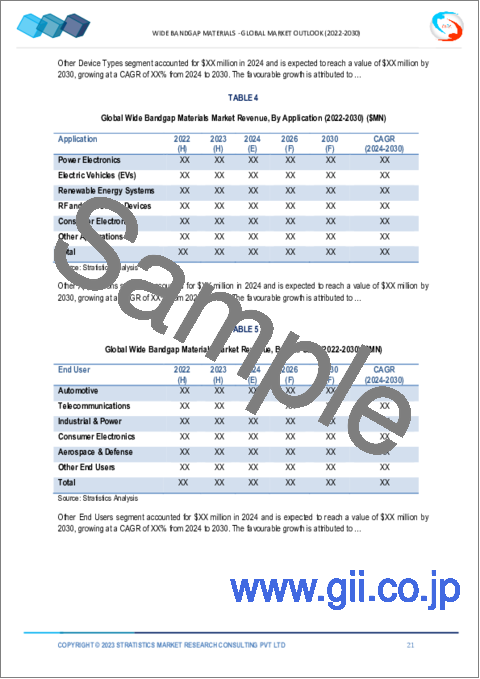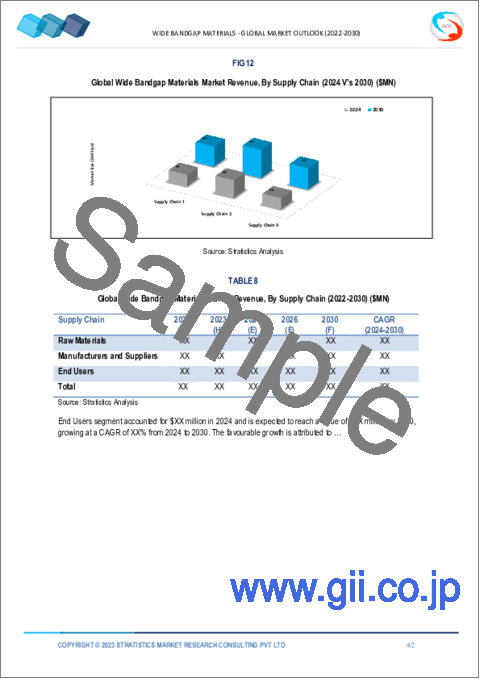|
|
市場調査レポート
商品コード
1603856
ワイドバンドギャップ材料の2030年までの市場予測: 材料タイプ別、サプライチェーン別、デバイスタイプ別、用途別、エンドユーザー別、地域別の世界分析Wide Bandgap Materials Market Forecasts to 2030 - Global Analysis By Material Type (Silicon Carbide (SiC), Gallium Nitride (GaN), Aluminum Nitride (AlN), Diamond, and Other Materials), Supply Chain, Device Type, Application, End User and By Geography |
||||||
カスタマイズ可能
|
|||||||
| ワイドバンドギャップ材料の2030年までの市場予測: 材料タイプ別、サプライチェーン別、デバイスタイプ別、用途別、エンドユーザー別、地域別の世界分析 |
|
出版日: 2024年11月11日
発行: Stratistics Market Research Consulting
ページ情報: 英文 200+ Pages
納期: 2~3営業日
|
全表示
- 概要
- 図表
- 目次
Stratistics MRCによると、世界のワイドバンドギャップ材料市場は2024年に3億2,023万米ドルを占め、2030年には7億4,847万米ドルに達すると予測され、予測期間中のCAGRは15.2%です。
ワイドバンドギャップ(WBG)半導体は、シリコンのような従来の半導体材料よりもバンドギャップが広いため、より高い電圧、周波数、温度で機能する可能性があります。窒化ガリウム(GaN)や炭化ケイ素(SiC)はその重要な例です。WBG材料の市場は、5G通信、再生可能エネルギーシステム、特にEVにおけるエネルギー効率の高いパワーエレクトロニクスへのニーズの高まりといった要因によって牽引されています。より優れた熱管理、エネルギー損失の減少、性能の向上は、パワー・アプリケーションにおけるこれらの材料によって可能になります。
エリクソンによると、5Gの契約数は2022年第1四半期に7,000万件増加し、約6億2,000万件に達しました。
エネルギー効率の高いパワーエレクトロニクスへの需要の高まり
ワイドバンドギャップ材料の市場を後押ししている主な要因は、エネルギー効率の高いパワーエレクトロニクスに対するニーズの高まりです。産業界が二酸化炭素排出量の削減やエネルギー消費量の削減に取り組む中で、より効果的な電力変換・管理ソリューションの必要性が高まっています。SiCやGaNなどのWBG材料は、従来のシリコンベースの半導体よりも性能が高く効率的であるため、パワーエレクトロニクスアプリケーションに最適です。これらの材料のおかげで、より小さく、より軽く、より効果的な電力システムを開発することができ、多くのエネルギーを節約し、環境への悪影響を少なくすることができます。
限られた原料しか入手できない
ワイドバンドギャップ(WBG)材料市場では、原材料、特に炭化ケイ素(SiC)や窒化ガリウム(GaN)のような必須材料の不足が大きな障害となっています。これらの材料は抽出や加工が難しく、従来のシリコンよりも一般的ではありません。効率的なパワーエレクトロニクスの製造には高品質のSiCやGaNが必要だが、これらの材料は希少で製造が難しく、製造コストを引き上げています。電気自動車、5G、再生可能エネルギーなどの分野でのWBG材料の採用は、この供給制限によって遅れる可能性があり、その結果、製造の遅れ、コストの上昇、サプライチェーンの脆弱性が生じる可能性があります。
5Gと通信の進歩
GaNは、高周波での卓越した性能、高電力密度、優れた効率により、5G基地局、レーダーシステム、RF電力増幅器に最適です。WBG材料は、より迅速で信頼性の高い通信ネットワークの必要性が高まる中、通信機器がより高いデータスループット、低遅延、より優れたネットワークカバレッジを管理することを可能にします。次世代通信インフラストラクチャーの厳しい要件を満たし、5Gやその先での幅広い利用を促進するためには、GaNは高温・高電圧で効果的に機能しなければならないです。
複雑な製造プロセス
炭化ケイ素(SiC)や窒化ガリウム(GaN)のようなWBG材料は、特定の方法と高精度の機械を使って製造されます。最高のデバイス性能を達成するためには、大規模で高品質なWBG結晶成長と、洗練されたエピタキシャル成長技術の開発が不可欠です。WBGデバイスの広範な使用は、これらの複雑な製造手順によって制約を受ける可能性があり、製造コストも上昇する可能性があります。しかし、WBG材料の将来性を完全に実現するため、継続的な研究開発努力が、製造プロセスの強化とコスト削減に注がれています。
COVID-19の影響
COVID-19の流行は、ワイドバンドギャップ材料分野にサプライチェーンの混乱と生産の遅れをもたらしました。研究開発努力は妨げられ、工業操業は各地域で実施された操業停止や制限によって影響を受けた。しかし、この流行は、高性能でエネルギー効率の高いソリューションへのニーズの高まりに対応するため、WBGデバイスのような最先端技術の開発を早めることにもなった。経済が回復し、産業界が新常態に適応するにつれ、WBG素材の需要は着実に増加しました。この背景には、データセンター、再生可能エネルギーシステム、電気自動車の拡大があります。
予測期間中、炭化ケイ素(SiC)セグメントが最大となる見込み
炭化ケイ素(SiC)セグメントは、従来のシリコンと比較して、より高い電圧、温度、周波数で動作する能力があるため、最大になると推定されます。SiCは熱伝導率が高く電力効率が高いため、産業用パワーエレクトロニクス、再生可能エネルギーシステム、電気自動車(EV)に最適です。エネルギー損失を低減し、充電器、インバーター、電力変換器の性能を向上させる可能性もあるため、より持続可能で効率的な運用を目指す業界全体で採用が進んでいます。
予測期間中にCAGRが最も高くなると予想される自動車分野
自動車分野は、ハイブリッド車や電気自動車の需要の高まりにより、予測期間中に最も高いCAGRを記録すると予測されています。SiCの高温・高電圧における卓越した効率は、車載充電器、バッテリー管理システム、EVパワートレインの改善に不可欠です。航続距離を伸ばし、エネルギー損失を低減し、電気自動車の総合効率を高める。WBG材料は、生産者が持続可能性とエネルギー効率に集中する中、自動車部門の変化する要求を満たすために極めて重要です。
最大のシェアを占める地域
再生可能エネルギー源の利用増加、電気自動車(EV)の需要拡大、急速な産業化により、予測期間中、アジア太平洋地域が最大の市場シェアを占めると予想されます。炭化ケイ素(SiC)と窒化ガリウム(GaN)は、中国、日本、韓国を含む国々で、パワーエレクトロニクス、電気自動車インフラ、通信に広く使用されています。さらに、グリーン技術やエネルギー効率を支援する政府プログラムがWBG材料の使用を加速させており、この地域の市場拡大を後押ししています。
CAGRが最も高い地域:
高性能パワーエレクトロニクス、再生可能エネルギー源、電気自動車(EV)に対するニーズの高まりにより、北米が予測期間中に最も高いCAGRを示すと予測されます。市場が拡大しているのは、5G通信、ソーラー・インバータ、EVパワートレインで炭化ケイ素(SiC)と窒化ガリウム(GaN)の使用が増加しているためです。さらに、自動車、通信、産業用アプリケーションなど、さまざまな産業へのWBG材料の統合は、北米の持続可能性、エネルギー効率の重視、グリーン技術に対する政府の優遇措置によって支えられています。
無料カスタマイズサービス:
本レポートをご購読のお客様には、以下の無料カスタマイズオプションのいずれかをご利用いただけます:
- 企業プロファイル
- 追加市場企業の包括的プロファイリング(3社まで)
- 主要企業のSWOT分析(3社まで)
- 地域セグメンテーション
- 顧客の関心に応じた主要国の市場推計・予測・CAGR(注:フィージビリティチェックによる)
- 競合ベンチマーキング
- 製品ポートフォリオ、地理的プレゼンス、戦略的提携に基づく主要企業のベンチマーキング
目次
第1章 エグゼクティブサマリー
第2章 序文
- 概要
- ステークホルダー
- 調査範囲
- 調査手法
- データマイニング
- データ分析
- データ検証
- 調査アプローチ
- 調査情報源
- 1次調査情報源
- 2次調査情報源
- 前提条件
第3章 市場動向分析
- 促進要因
- 抑制要因
- 機会
- 脅威
- 用途分析
- エンドユーザー分析
- 新興市場
- COVID-19の影響
第4章 ポーターのファイブフォース分析
- 供給企業の交渉力
- 買い手の交渉力
- 代替品の脅威
- 新規参入業者の脅威
- 競争企業間の敵対関係
第5章 世界のワイドバンドギャップ材料市場:材料タイプ別
- シリコンカーバイド(SiC)
- 窒化ガリウム(GaN)
- 窒化アルミニウム(AlN)
- ダイヤモンド
- その他の材料タイプ
第6章 世界のワイドバンドギャップ材料市場:サプライチェーン別
- 原材料
- メーカーとサプライヤー
- エンドユーザー
第7章 世界のワイドバンドギャップ材料市場:デバイスタイプ別
- パワートランジスタ
- ダイオード
- モジュール
- RFデバイス
- その他のデバイスタイプ
第8章 世界のワイドバンドギャップ材料市場:用途別
- パワーエレクトロニクス
- 電気自動車(EV)
- 再生可能エネルギーシステム
- RFおよびマイクロ波デバイス
- 家電
- その他の用途
第9章 世界のワイドバンドギャップ材料市場:エンドユーザー別
- 自動車
- 通信
- 産業・電力
- 家電
- 航空宇宙・防衛
- その他のエンドユーザー
第10章 世界のワイドバンドギャップ材料市場:地域別
- 北米
- 米国
- カナダ
- メキシコ
- 欧州
- ドイツ
- 英国
- イタリア
- フランス
- スペイン
- その他欧州
- アジア太平洋
- 日本
- 中国
- インド
- オーストラリア
- ニュージーランド
- 韓国
- その他アジア太平洋地域
- 南米
- アルゼンチン
- ブラジル
- チリ
- その他南米
- 中東・アフリカ
- サウジアラビア
- アラブ首長国連邦
- カタール
- 南アフリカ
- その他中東とアフリカ
第11章 主な発展
- 契約、パートナーシップ、コラボレーション、合弁事業
- 買収と合併
- 新製品発売
- 事業拡大
- その他の主要戦略
第12章 企業プロファイリング
- Infineon Technologies AG
- ON Semiconductor Corporation
- STMicroelectronics N.V.
- Texas Instruments Incorporated
- ROHM Semiconductor
- NXP Semiconductors N.V.
- Qorvo, Inc.
- Schaefer, Inc.
- General Electric Company(GE)
- Analog Devices, Inc.
- Macom Technology Solutions
- Applied Materials, Inc.
- Mitsubishi Electric Corporation
- II-VI Incorporated
- Toshiba Corporation
- Broadcom Inc.
- Norstel AB
- Sumitomo Electric Industries, Ltd.
- Samsung Electronics Co., Ltd.
List of Tables
- Table 1 Global Wide Bandgap Materials Market Outlook, By Region (2022-2030) ($MN)
- Table 2 Global Wide Bandgap Materials Market Outlook, By Material Type (2022-2030) ($MN)
- Table 3 Global Wide Bandgap Materials Market Outlook, By Silicon Carbide (SiC) (2022-2030) ($MN)
- Table 4 Global Wide Bandgap Materials Market Outlook, By Gallium Nitride (GaN) (2022-2030) ($MN)
- Table 5 Global Wide Bandgap Materials Market Outlook, By Aluminum Nitride (AlN) (2022-2030) ($MN)
- Table 6 Global Wide Bandgap Materials Market Outlook, By Diamond (2022-2030) ($MN)
- Table 7 Global Wide Bandgap Materials Market Outlook, By Other Materials (2022-2030) ($MN)
- Table 8 Global Wide Bandgap Materials Market Outlook, By Supply Chain (2022-2030) ($MN)
- Table 9 Global Wide Bandgap Materials Market Outlook, By Raw Materials (2022-2030) ($MN)
- Table 10 Global Wide Bandgap Materials Market Outlook, By Manufacturers and Suppliers (2022-2030) ($MN)
- Table 11 Global Wide Bandgap Materials Market Outlook, By End Users (2022-2030) ($MN)
- Table 12 Global Wide Bandgap Materials Market Outlook, By Device Type (2022-2030) ($MN)
- Table 13 Global Wide Bandgap Materials Market Outlook, By Power Transistors (2022-2030) ($MN)
- Table 14 Global Wide Bandgap Materials Market Outlook, By Diodes (2022-2030) ($MN)
- Table 15 Global Wide Bandgap Materials Market Outlook, By Modules (2022-2030) ($MN)
- Table 16 Global Wide Bandgap Materials Market Outlook, By RF Devices (2022-2030) ($MN)
- Table 17 Global Wide Bandgap Materials Market Outlook, By Other Device Types (2022-2030) ($MN)
- Table 18 Global Wide Bandgap Materials Market Outlook, By Application (2022-2030) ($MN)
- Table 19 Global Wide Bandgap Materials Market Outlook, By Power Electronics (2022-2030) ($MN)
- Table 20 Global Wide Bandgap Materials Market Outlook, By Electric Vehicles (EVs) (2022-2030) ($MN)
- Table 21 Global Wide Bandgap Materials Market Outlook, By Renewable Energy Systems (2022-2030) ($MN)
- Table 22 Global Wide Bandgap Materials Market Outlook, By RF and Microwave Devices (2022-2030) ($MN)
- Table 23 Global Wide Bandgap Materials Market Outlook, By Consumer Electronics (2022-2030) ($MN)
- Table 24 Global Wide Bandgap Materials Market Outlook, By Other Applications (2022-2030) ($MN)
- Table 25 Global Wide Bandgap Materials Market Outlook, By End User (2022-2030) ($MN)
- Table 26 Global Wide Bandgap Materials Market Outlook, By Automotive (2022-2030) ($MN)
- Table 27 Global Wide Bandgap Materials Market Outlook, By Telecommunications (2022-2030) ($MN)
- Table 28 Global Wide Bandgap Materials Market Outlook, By Industrial & Power (2022-2030) ($MN)
- Table 29 Global Wide Bandgap Materials Market Outlook, By Consumer Electronics (2022-2030) ($MN)
- Table 30 Global Wide Bandgap Materials Market Outlook, By Aerospace & Defense (2022-2030) ($MN)
- Table 31 Global Wide Bandgap Materials Market Outlook, By Other End Users (2022-2030) ($MN)
Note: Tables for North America, Europe, APAC, South America, and Middle East & Africa Regions are also represented in the same manner as above.
According to Stratistics MRC, the Global Wide Bandgap Materials Market is accounted for $320.23 million in 2024 and is expected to reach $748.47 million by 2030 growing at a CAGR of 15.2% during the forecast period. Wide Bandgap (WBG) semiconductors may function at greater voltages, frequencies, and temperatures because they have a wider bandgap than traditional semiconductor materials like silicon. Gallium nitride (GaN) and silicon carbide (SiC) are important examples. The market for WBG materials is driven by factors such as 5G telecommunications, renewable energy systems, and the increasing need for energy-efficient power electronics, particularly in EVs. Better thermal management, decreased energy loss, and increased performance are made possible by these materials in power applications.
According to Ericsson, the number of 5G subscriptions increased by 70 million during the first quarter of 2022, reaching about 620 million.
Market Dynamics:
Driver:
Increasing demand for energy-efficient power electronics
A key factor propelling the market for wide bandgap materials is the growing need for energy-efficient power electronics. More effective power conversion and management solutions are becoming more and more necessary as industries work to cut carbon emissions and consume less energy. WBG materials, such as SiC and GaN, are perfect for power electronics applications because they perform better and are more efficient than conventional silicon-based semiconductors. Smaller, lighter, and more effective power systems can be developed thanks to these materials, which will save a lot of energy and have a less negative effect on the environment.
Restraint:
Limited availability of raw materials
In the Wide Bandgap (WBG) Materials market, a major obstacle is the scarcity of raw materials, especially for essential materials like silicon carbide (SiC) and gallium nitride (GaN). These materials are more difficult to extract and process, and they are less common than conventional silicon. The fabrication of efficient power electronics requires high-quality SiC and GaN, but these materials are scarce and difficult to manufacture, which raises production costs. The adoption of WBG materials in sectors including electric vehicles, 5G, and renewable energy may be slowed down by this supply limitation, which might result in manufacturing delays, increased costs, and supply chain vulnerabilities.
Opportunity:
Advancements in 5G and telecommunications
GaN is perfect for 5G base stations, radar systems, and RF power amplifiers due to its exceptional performance at high frequencies, high power densities, and great efficiency. WBG materials allow telecom equipment to manage higher data throughput, lower latency, and better network coverage as the need for quicker, more dependable communication networks increases. In order to meet the demanding requirements of next-generation telecommunications infrastructure and promote wider use in 5G and beyond, GaN must be able to function effectively at high temperatures and voltages.
Threat:
Complex manufacturing processes
WBG materials, like silicon carbide (SiC) and gallium nitride (GaN), are made using specific methods and highly accurate machinery. To achieve the best device performance, large-scale, high-quality WBG crystal growth and the development of sophisticated epitaxial growth techniques are crucial. The extensive use of WBG devices may be constrained by these intricate manufacturing procedures, which may also raise production costs. To fully realize the promise of WBG materials, however, continuous research and development efforts are concentrated on enhancing manufacturing processes and cutting expenses.
Covid-19 Impact
The COVID-19 epidemic caused supply chain disruptions and production delays in the wide bandgap materials sector. Research and development efforts were hampered and industrial operations were affected by lockdowns and limitations implemented in different regions. But the epidemic also hastened the development of cutting-edge technologies, such as WBG devices, to meet the growing need for high-performance and energy-efficient solutions. Demand for WBG materials steadily rose as economies recovered and industry adjusted to the new normal. This was due in part to the expansion of data centers, renewable energy systems, and electric vehicles.
The silicon carbide (SiC) segment is expected to be the largest during the forecast period
The silicon carbide (SiC) segment is estimated to be the largest, due to its ability to operate at higher voltages, temperatures, and frequencies compared to traditional silicon. Due to its high thermal conductivity and power efficiency, SiC is perfect for industrial power electronics, renewable energy systems, and electric vehicles (EVs). Its potential to lower energy losses and enhance performance in chargers, inverters, and power converters is also encouraging adoption across industries looking to operate more sustainably and efficiently.
The automotive segment is expected to have the highest CAGR during the forecast period
The automotive segment is anticipated to witness the highest CAGR during the forecast period, due to the rising demand for hybrid and electric automobiles. SiC's exceptional efficiency at high temperatures and voltages is essential for improving on-board chargers, battery management systems, and EV powertrains. It enhances range, lowers energy loss, and boosts electric cars' overall efficiency. WBG materials are crucial for satisfying the changing demands of the automobile sector as producers concentrate on sustainability and energy efficiency.
Region with largest share:
Asia Pacific is expected to have the largest market share during the forecast period due to increasing use of renewable energy sources, expanding demand for electric vehicles (EVs), and fast industrialization. Silicon carbide (SiC) and gallium nitride (GaN) are widely used in power electronics, electric vehicle infrastructure, and telecommunications in nations including China, Japan, and South Korea. Furthermore, government programs that support green technology and energy efficiency are speeding up the use of WBG materials, which is propelling the region's market expansion.
Region with highest CAGR:
North America is projected to witness the highest CAGR over the forecast period, owing to the rising need for high-performance power electronics, renewable energy sources, and electric vehicles (EVs). The market is expanding because to the increasing use of silicon carbide (SiC) and gallium nitride (GaN) in 5G telecommunications, solar inverters, and EV powertrains. Furthermore, the integration of WBG materials into a variety of industries, such as automotive, telecommunications, and industrial applications, is supported by North America's emphasis on sustainability, energy efficiency, and government incentives for green technologies.
Key players in the market
Some of the key players profiled in the Wide Bandgap Materials Market include Infineon Technologies AG, ON Semiconductor Corporation, STMicroelectronics N.V., Texas Instruments Incorporated, ROHM Semiconductor, NXP Semiconductors N.V., Qorvo, Inc., Schaefer, Inc., General Electric Company (GE), Analog Devices, Inc., Macom Technology Solutions, Applied Materials, Inc., Mitsubishi Electric Corporation, II-VI Incorporated, Toshiba Corporation, Broadcom Inc, Norstel AB, Sumitomo Electric Industries, Ltd., and Samsung Electronics Co., Ltd.
Key Developments:
In June 2023, Infineon launched its next-generation 1200V SiC MOSFETs designed to offer higher power efficiency and lower switching losses. These MOSFETs cater to a variety of applications, including electric vehicles (EVs) and renewable energy systems.
In May 2023, STMicroelectronics introduced a new series of Gallium Nitride (GaN) power transistors for high-efficiency power systems, addressing the growing demand for fast-charging infrastructure, 5G, and data centers.
In January 2023, Rohm introduced new 1200V SiC MOSFETs aimed at the electric vehicle (EV) market, delivering superior power density and thermal performance. These devices help enhance the efficiency of EV powertrains and charging stations.
Material Types Covered:
- Silicon Carbide (SiC)
- Gallium Nitride (GaN)
- Aluminum Nitride (AlN)
- Diamond
- Other Materials
Supply Chains Covered:
- Raw Materials
- Manufacturers and Suppliers
- End Users
Device Types Covered:
- Power Transistors
- Diodes
- Modules
- RF Devices
- Other Device Types
Applications Covered:
- Power Electronics
- Electric Vehicles (EVs)
- Renewable Energy Systems
- RF and Microwave Devices
- Consumer Electronics
- Other Applications
End Users Covered:
- Automotive
- Telecommunications
- Industrial & Power
- Consumer Electronics
- Aerospace & Defense
- Other End Users
Regions Covered:
- North America
- US
- Canada
- Mexico
- Europe
- Germany
- UK
- Italy
- France
- Spain
- Rest of Europe
- Asia Pacific
- Japan
- China
- India
- Australia
- New Zealand
- South Korea
- Rest of Asia Pacific
- South America
- Argentina
- Brazil
- Chile
- Rest of South America
- Middle East & Africa
- Saudi Arabia
- UAE
- Qatar
- South Africa
- Rest of Middle East & Africa
What our report offers:
- Market share assessments for the regional and country-level segments
- Strategic recommendations for the new entrants
- Covers Market data for the years 2022, 2023, 2024, 2026, and 2030
- Market Trends (Drivers, Constraints, Opportunities, Threats, Challenges, Investment Opportunities, and recommendations)
- Strategic recommendations in key business segments based on the market estimations
- Competitive landscaping mapping the key common trends
- Company profiling with detailed strategies, financials, and recent developments
- Supply chain trends mapping the latest technological advancements
Free Customization Offerings:
All the customers of this report will be entitled to receive one of the following free customization options:
- Company Profiling
- Comprehensive profiling of additional market players (up to 3)
- SWOT Analysis of key players (up to 3)
- Regional Segmentation
- Market estimations, Forecasts and CAGR of any prominent country as per the client's interest (Note: Depends on feasibility check)
- Competitive Benchmarking
- Benchmarking of key players based on product portfolio, geographical presence, and strategic alliances
Table of Contents
1 Executive Summary
2 Preface
- 2.1 Abstract
- 2.2 Stake Holders
- 2.3 Research Scope
- 2.4 Research Methodology
- 2.4.1 Data Mining
- 2.4.2 Data Analysis
- 2.4.3 Data Validation
- 2.4.4 Research Approach
- 2.5 Research Sources
- 2.5.1 Primary Research Sources
- 2.5.2 Secondary Research Sources
- 2.5.3 Assumptions
3 Market Trend Analysis
- 3.1 Introduction
- 3.2 Drivers
- 3.3 Restraints
- 3.4 Opportunities
- 3.5 Threats
- 3.6 Application Analysis
- 3.7 End User Analysis
- 3.8 Emerging Markets
- 3.9 Impact of Covid-19
4 Porters Five Force Analysis
- 4.1 Bargaining power of suppliers
- 4.2 Bargaining power of buyers
- 4.3 Threat of substitutes
- 4.4 Threat of new entrants
- 4.5 Competitive rivalry
5 Global Wide Bandgap Materials Market, By Material Type
- 5.1 Introduction
- 5.2 Silicon Carbide (SiC)
- 5.3 Gallium Nitride (GaN)
- 5.4 Aluminum Nitride (AlN)
- 5.5 Diamond
- 5.6 Other Materials
6 Global Wide Bandgap Materials Market, By Supply Chain
- 6.1 Introduction
- 6.2 Raw Materials
- 6.3 Manufacturers and Suppliers
- 6.4 End Users
7 Global Wide Bandgap Materials Market, By Device Type
- 7.1 Introduction
- 7.2 Power Transistors
- 7.3 Diodes
- 7.4 Modules
- 7.5 RF Devices
- 7.6 Other Device Types
8 Global Wide Bandgap Materials Market, By Application
- 8.1 Introduction
- 8.2 Power Electronics
- 8.3 Electric Vehicles (EVs)
- 8.4 Renewable Energy Systems
- 8.5 RF and Microwave Devices
- 8.6 Consumer Electronics
- 8.7 Other Applications
9 Global Wide Bandgap Materials Market, By End User
- 9.1 Introduction
- 9.2 Automotive
- 9.3 Telecommunications
- 9.4 Industrial & Power
- 9.5 Consumer Electronics
- 9.6 Aerospace & Defense
- 9.7 Other End Users
10 Global Wide Bandgap Materials Market, By Geography
- 10.1 Introduction
- 10.2 North America
- 10.2.1 US
- 10.2.2 Canada
- 10.2.3 Mexico
- 10.3 Europe
- 10.3.1 Germany
- 10.3.2 UK
- 10.3.3 Italy
- 10.3.4 France
- 10.3.5 Spain
- 10.3.6 Rest of Europe
- 10.4 Asia Pacific
- 10.4.1 Japan
- 10.4.2 China
- 10.4.3 India
- 10.4.4 Australia
- 10.4.5 New Zealand
- 10.4.6 South Korea
- 10.4.7 Rest of Asia Pacific
- 10.5 South America
- 10.5.1 Argentina
- 10.5.2 Brazil
- 10.5.3 Chile
- 10.5.4 Rest of South America
- 10.6 Middle East & Africa
- 10.6.1 Saudi Arabia
- 10.6.2 UAE
- 10.6.3 Qatar
- 10.6.4 South Africa
- 10.6.5 Rest of Middle East & Africa
11 Key Developments
- 11.1 Agreements, Partnerships, Collaborations and Joint Ventures
- 11.2 Acquisitions & Mergers
- 11.3 New Product Launch
- 11.4 Expansions
- 11.5 Other Key Strategies
12 Company Profiling
- 12.1 Infineon Technologies AG
- 12.2 ON Semiconductor Corporation
- 12.3 STMicroelectronics N.V.
- 12.4 Texas Instruments Incorporated
- 12.5 ROHM Semiconductor
- 12.6 NXP Semiconductors N.V.
- 12.7 Qorvo, Inc.
- 12.8 Schaefer, Inc.
- 12.9 General Electric Company (GE)
- 12.10 Analog Devices, Inc.
- 12.11 Macom Technology Solutions
- 12.12 Applied Materials, Inc.
- 12.13 Mitsubishi Electric Corporation
- 12.14 II-VI Incorporated
- 12.15 Toshiba Corporation
- 12.16 Broadcom Inc.
- 12.17 Norstel AB
- 12.18 Sumitomo Electric Industries, Ltd.
- 12.19 Samsung Electronics Co., Ltd.






